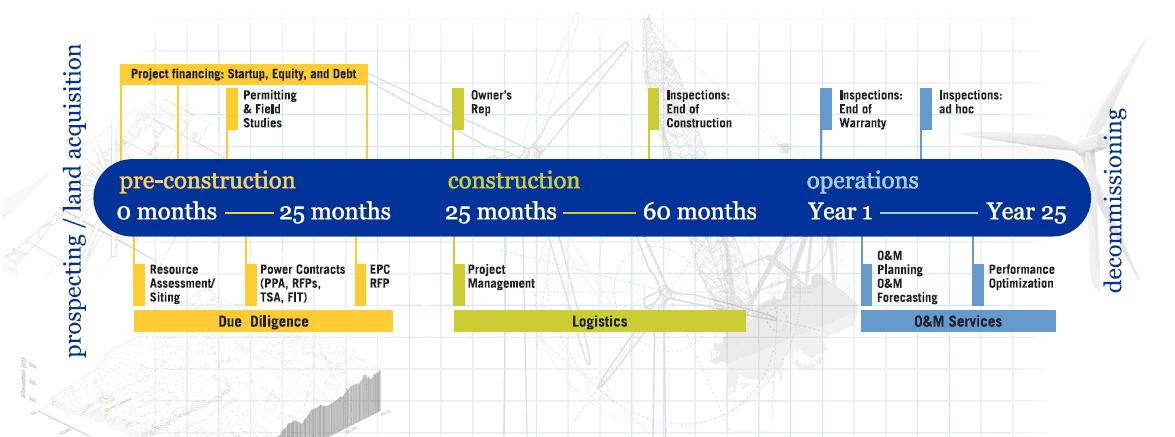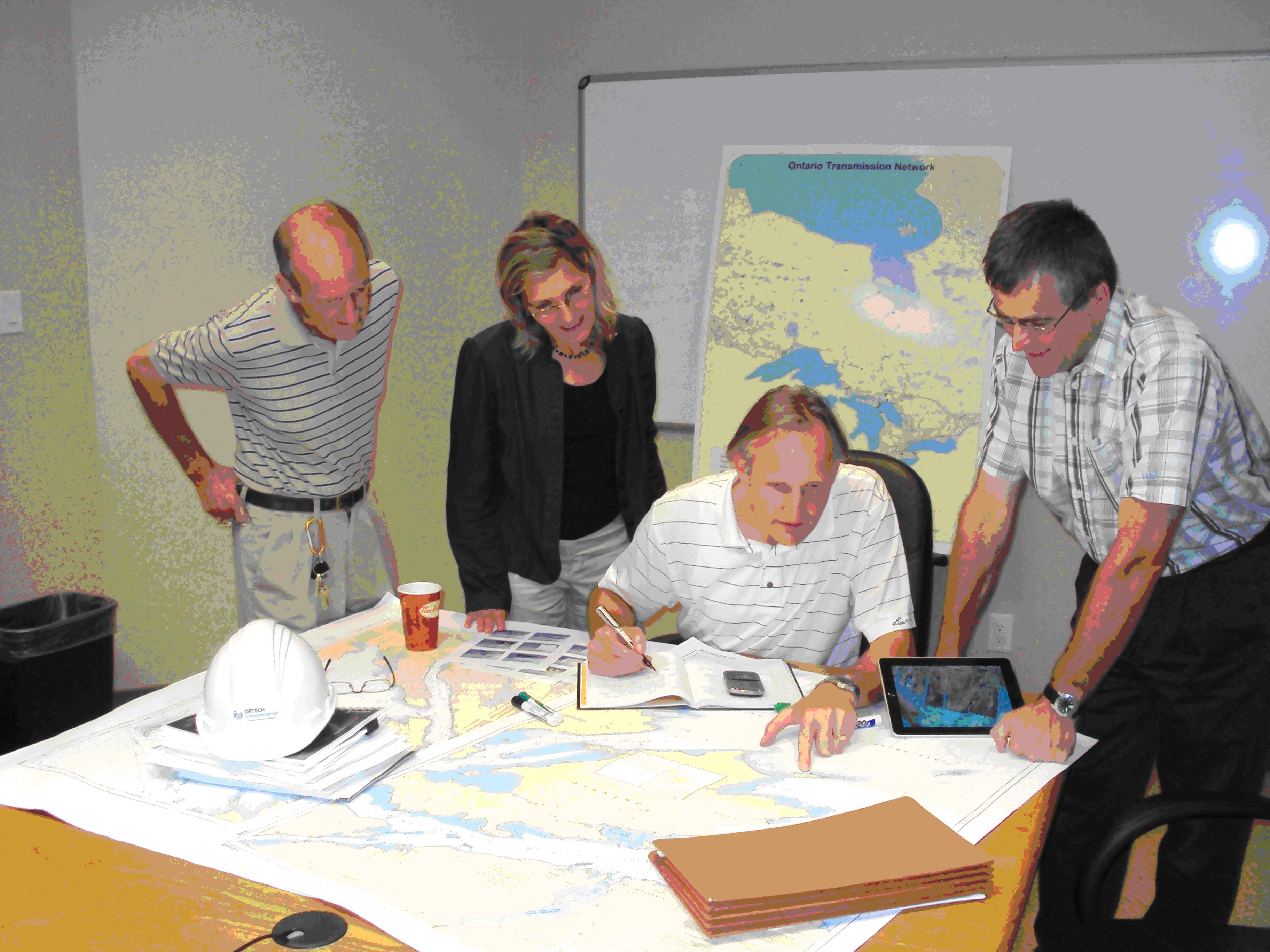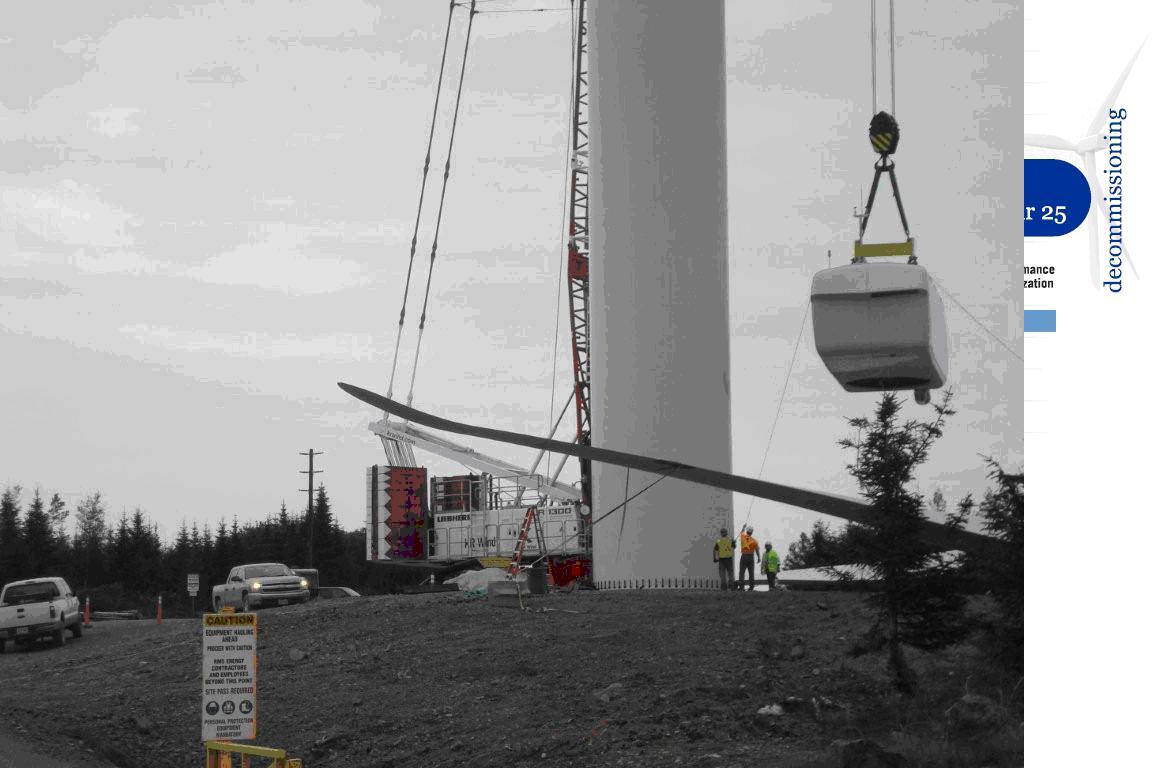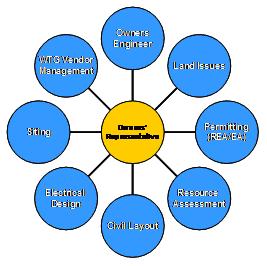The following article has been adapted with permission from a bulletin circulated by Ortech in November 2010. For the original document in Word format, please click here .
Now that your firm has just been awarded a Power Purchase Agreement (PPA) or RFP award or a Feed-in Tariff (F.I.T.) contract, what do you do next?
You need to start the process that will lead to the Commercial Operation Date (C.O.D.) of your solar park, wind farm or hydro plant. It's a manageable but daunting process, one fraught with risk and stress and the dreaded unknown.
Every firm is different from large established developers to small firms working on their first project to a community wind project with multiple leaders. Regardless of your size and financial resources, effective project management is crucial.
The graphic below illustrates a typical renewable energy project lifecycle. All projects are different but the image provides general rule-off-thumb timelines. This document concentrates on the logistics phase or construction phase of the lifecycle. As shown, initial timelines for typical renewable energy projects can be tight.
Project Management Tips:
Here are some tips to ensure the project management role is properly executed. In order to stay within your budget and timeframe, you will need to maximize the effectiveness of the project management function.
Define the Scope and Objectives: The scope defines the boundary of the project. One of the first tasks is to fine tune the scope and discuss the strategy around completing the project. A detailed definition of the scope will help to structure the rest of your project. Once your team has agreed on the defined scope and objectives, your CFO or equity sponsor should review and agree to them (or better yet be part of the development team).
Project Planning: Planning requires the technical project manager to decide on the people, resources, budget, scope and schedule to complete the project.
In this phase, your project manager should defile what activities are required to produce the deliverables. One approach is to divide the overall project scope into the following key service areas:
1. resource assessment (wind, solar, hydro, bio, etc),
2. legal and land use (e,g. contracts, land tenure, etc.),
3. civil / foundation engineering,
4. environmental permitting (REA / EA),
5. electrical engineering,
6. procure and construct (P&C),
7. other services (e.g. project management, financial modeling, etc.).
With renewable energy projects, an experienced project manager will understand what needs to be done. Good project managers' fine tune the process as the project proceeds. Setting milestones which indicate critical dates during the project is a key task in meeting the schedule and managing overall risk.
Communication: Project plans are of limited use unless they have been communicated effectively to the project team. This should be done through various mediums to ensure all stakeholders understand the plan and any changes to it.
Tracking and Reporting Project Progress: Your consultant or project manager should continuously monitor and compare the actual progress with the planned progress. Your project manager should receive and review progress reports from the various project team members on a regularly scheduled basis. Variations between the actual and planned cost, schedule and scope are recorded, assessed for risk management implications and acted upon on an as required basis. All major variations and corrective actions should be reported to the executive team.
Initially, weekly (or more frequently, if deemed necessary, especially during the critical initial stages of the Project) teleconference meetings should be conducted between the executive team, the technical project manager and support team as required. These weekly calls should include a status summary of previous tasks and priority setting for short and long term tasks moving forward.
Change Management: Stakeholders often change their mind on priorities and what must be delivered. Sometimes the business environment changes after the project starts, so assumptions made at the beginning of the project may no longer be valid. If a technical project manager accepted all changes into the project, the project would inevitably go over budget, be late or might never be completed. Your vendor or project manager should manage these changes by early notification of changes to the project owner together with recommendations. A. change order system should be instituted to track and control variations to the initial plan.
Risk Management: Risks include events which can adversely affect the successful outcome of the project. Risks will vary for each renewable energy project but the main risks must be identified as soon as possible. Plans must be made to avoid risks, or, if the risk cannot be avoided, to mitigate the risk to lessen its impact if it occurs.
Project Management Approaches: Two possible approaches to the project management tasks are:
1. Turnkey Model, and
2. Progression Model
Turnkey Model: This approach is best for risk adverse developers, financial investors and managers that want one “corporate tie to shake” should the project start to fall off the rails. Typically, the overall development cost for the model is fixed and should be budgeted around 2-5% of the total capital cost. The range is a factor of size as a lot of these costs are fixed regardless of the size of the project. In this approach the vendor manages all facets and is responsible for financial components. The vendors need to be experienced in managing projects and it is more risky to work with a firm that is just entering the market.
Advantages:
· Alignment of intent (where payments are tied to achieving milestones),
· Improved efficiency (Experienced EPC/Project Management vendors will know the short cuts),
· Cost certainty (fixed and only if successful),
· Risk sharing,
· Simplicity (loss time spent managing the vendor) and,
· Reduced EPC vendor management costs.
Disadvantages:
· Filed Cost/Financial certainty equates to higher prices; with this pricing
· model, vendors increase their price points to balance increased risks,
· Lack of control. on project components like engineering design and
· permitting, and
· Best of Breed might be sacrificed for lower priced/lower quality providers.
Progression Model:
This approach is better suited to developers that devote to a single project but not enough time to devote to a single project. In this approach, the vendor only provides project management tasks and maybe some of the development tasks.
Developers often have preferred vendors and just require a resource or vendor to manage the project and report back. Typical costs are lower as pricing does not require a risk management buffer. Also, a competitive bidding process can be created to drive costs down without sacrificing quality and experience. This model has an overall development cost range of 1-4% of the total capital cost.
Advantages:
· Puts the vendor in the position to look at what is "Right" for the developer first. A successful project means future work. That is a very good motivator for a vendor in the professional services market,
· The developer has more control over the project and quality of the vendors working on the project,
· Best of Breed is not sacrificed; Experienced vendors want your business and they may be willing to reduce their prices to obtain long term contracts and relationships, and
· Total Cost of Ownership is lower without sacrificing quality or experience.
Disadvantages;
· Vendor Management costs are higher,
· Developer must be more engaged to ensure the project is on time and on budget,
· Inexperienced project manager can cause numerous problems such as scope creep and loss of control leading to other vendors running the project, and
· Many facets or moving parts, issues will arise, budget and timelines may to be stressed and difficult to obtain.
In conclusion, depending on your confidence and experience level, project management can make or break your ability to successfully develop a renewable energy project on time and on budget. Choosing the right solution provider or approach is crucial. The best approach is to assess your internal capabilities and compare it with your workload. A gap analysis of what you do well and what you should outsource is a good start. Then choose the best approach to project management, based on either the concepts outlined in this newsletter or a hybrid of your own making.
ORTECH Power is a renewable energy consulting firm that specializes in getting renewable energy projects completed; from project management to permitting to financial analysis and ultimately to commissioning. ORTECH's practical experience provides its clients with sound advice during all phases of the lifecycle of a project. ORTECH provides a variety of Technical Services such as Due Diligence, Wind Resource Assessment, Micrositing / Layout, Financial Analysis, Engineering Support, O&M Budgeting / Forecasting, M&A Services, EPC RFP Support, Owners' Representative and Project Management Services. For further information, contact Michael Tingle at

